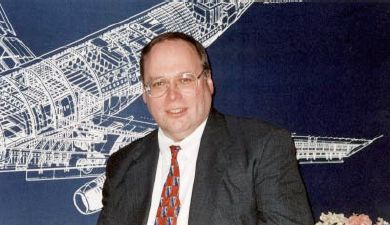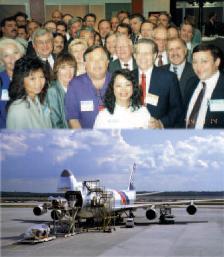|
You are currently
in the Archives section. Please be aware that some information and links
in the archived page may be outdated.
Click here
to return to the Archives' main page to see the list of archived articles.
|
A
R C H I V E S
A SALUTE
TO THE PEOPLE OF THE PORT AUTHORITY OF NEW YORK & NEW JERSEY

The
Friday before Labor Day is traditionally a “slow” news day in America.
News hawks usually find a few gas stations raising the cost of fuel
to cash in at the public’s expense on one more chase at Summer.
Now, with a power blackout a near distant
memory for cover, the big oil companies enmasse jumped in to the gouge
game with some gas at the pump on the New Jersey Turnpike going up as
much as 20 cents a gallon.
Talk about thieves in the night.
Best quote of the week came from Vice
President Cheney who said, of 50 million people who were blacked out
in that massive power failure, that he had not seen so many people in
the dark since he laid out the plan for war in Iraq to the American
public.
Elsewhere, Friday before Labor Day news
featured some poor slobs who work for the Port Authority of New York
& New Jersey turning over boxes of transcripts containing written versions
of the last messages recorded of the victims trapped inside the World
Trade Center September 11, 2001.
There they were, looking dazed and bewildered,
carrying typed copies of the recordings in brown boxes, that were snapped
up by a gang of media resembling wolves at a feeding frenzy.
We suppose that there must be good reason
for those papers to be revealed. But thinking ahead to next Labor Day,
that will occur again just before the third anniversary of the World
Trade Center tragedy, we wonder if another revelation will give the
daily papers and television another excuse to show us those horrible
9/11 crash and burn pictures again?
Of course, we should never forget. We
should always remember and pause to honor those who suffered and were
lost and were our heroes.
But for us, the people left alive down
here on the ground are the thing.
The people who died had their problems
ended in a horrible crescendo. The people left still here, have to endure
the pain.
Port Authority headquarters employees
have moved from the exalted heights to a bunch of non-descript offices
in some twenty-something floor buildings up on Madison Avenue in Manhattan
in New York City.
Many of these people who have spent their
entire lives serving the bi-state agency while rising up through the
ranks, lost both friends and family and co-workers on September 11,
2001.
But beyond the unendurable, The Port Authority
also lost its records, its picture histories, memorabilia, great works
of art, all its surroundings and trappings of power, not to mention
a comfortable familiar home, in one terrible instant.
Now aviation books and pictures, for example,
are being recovered one piece at time on Ebay and from private collections
and antique dealers.
Where once millions of artifacts and items
of historical record were carefully stored and preserved, now only copies
from other sources are slowly returning.
As we have often written, it is our belief
that Port Aviation Director Bill DeCota has performed the most impressive
job of any aviation director in history.
Against almost impossible odds of grief
and despair, with world economies tumbling and wrenching, somehow the
New York/New Jersey airports are on the move, building and developing
at almost a fever pitch.
As Bill DeCota has said:
“Our people have been just great. There
is a new face on the Port Authority. We are coming back.”
Most recently Lufthansa opened a new wonderworld
air cargo facility for the 21st century at JFK, as the newly revitalized
grand entrance Van Wyck Expressway road into the big airport appears
as a “miracle mile” of shiny new air cargo buildings for United, Korean,
Lufthansa, Austrian and others.
Maybe some social historian should do
a book about the people that 9/11 left behind at the Port Authority.
Never in aviation history has there been
a time like right now.
Certainly Port Authority people have come
through and shown great courage and resource.
Perhaps that’s a story for next Labor
Day.
 Closer
still is a rare and sadly dwindling number of air cargo pioneers
who gather occasionally around their shared experiences building
what once was the greatest all-cargo airline in the world, The Flying
Tiger Line. Closer
still is a rare and sadly dwindling number of air cargo pioneers
who gather occasionally around their shared experiences building
what once was the greatest all-cargo airline in the world, The Flying
Tiger Line.
As the Curtiss Commando (C46) sitting
in the snow at Idlewild (JFK) during the 1950s attests, Flying Tigers
got its first all cargo lift from the airplane that invented the
form.
But you don’t need to hear this stuff
from us.
Go right to the source.
On Saturday, October 25th, all Tigers
Alumni, Retirees and their friends are welcome to attend a reunion
in Los Angeles.
Flying Tigers Again will gather at
The Proud Bird 11022 Aviation Blvd. El Segundo, Calif. 90045.
RSVP by October 15 to Don Ashbrock,
2231 Kathryn Ave., Torrance, CA 90505 or contact Ernest Schimmer
(emschimmer@aol.com) for more details. Tariff is twenty bucks. The
memories and good times are priceless. |
|
|
Lynn Fritz Moved From
Air Cargo To Benefit The World
 We
love this guy, Lynn Fritz. We
love this guy, Lynn Fritz.
You should too.
What the esteemed Mr. Fritz did was
develop some of the most advanced logistics for air cargo in the
world, and then he sold his business, The Fritz Companies that he
founded and built up to 11,000 employees, to UPS for everything
and a bag of chips.
But rather than hang out on some golf
course or run around crying with a loaf of bread under each arm,
Lynn Fritz has spent most of what he learned, earned and brought
to air cargo, trying to streamline relief activities to help people
in ultimate danger around the world.
San Francisco-based Fritz Institute
is the fulcrum for advanced thinking in logistics being applied
to cut out the stalling effects of paperwork in getting help in
emergencies where it is needed and fast.
“We need to take the paper out of
relief work and save lives,” said Lynn Fritz as he introduced Humanitarian
Logistics Software that he developed.
The International Federation of Red
Cross and Red Crescent Societies, which have been working for the
past year on the development of a humanitarian logistics software
package with the San Francisco-based Fritz Institute agree whole
heartedly.
In-depth analysis of some of the largest
relief operations undertaken by the International Federation indicates
that the speed of the relief process can be increased 20% to 30%
using the Humanitarian Logistics Software, which goes “live” this
week at the International Federation’s Geneva-secretariat and will
gradually become standard for Red Cross/ Red Crescent operations
around the world.
Fritz Institute has invested over
a million dollars and 3,000 man-hours in an assessment of the International
Federation’s technology requirements.
“Aid donations are typically targeted
for direct relief and have not enabled humanitarian organizations
to adapt 21st Century technology and commercial logistics practices
to take the paperwork out of relief and to ensure that staff have
timely information about the availability and whereabouts of relief
supplies.
“This is where we feel our expertise
can make a difference,” said Lynn Fritz.
“There is no doubt that our resources
are being stretched to the limit as we see the numbers of people
affected by disasters worldwide increasing dramatically year after
year."
The strains on humanitarian organizations
responding to emergencies were underlined in this year’s World Disasters
Report, published by the International Federation. It showed that
last year alone, 256 million people were reported affected by disasters,
well above the decade’s annual average of 210 million.
“Humanitarian Logistics Software has
been designed based on the needs of relief organizations operating
during the emergency phase of a disaster.
“It is customized for the mobilization
and reporting needs of the disaster theatre.”
“The technology allows up-to-the-minute
tracking of food, non-food, gifts-in-kind and financial information
about the commodities in the supply chain.
“It also allows for the speedy reconciliation
of needs versus what has been pledged or purchased and does it at
a demand level per project per item.
“This is but one example of the synergy
that I would like to see developing much more between the expertise
and resources available from the private sector and the needs of
aid agencies responding to humanitarian emergencies. We need to
encourage more partnerships such as the one that has developed between
our Institute and the International Federation,” Lynn Fritz said.
You look at Lynn Fritz, and then everybody
else who has done well in air cargo over the years.
Then you wonder why air cargo has
not produced more people like Mr. Fritz.
He doesn’t mail it in, write a check
or just pay lip service either.
Our favorite picture so far this year
is 60 something Lynn Fritz somewhere
in the wilds of Africa humping sacks of rice on his shoulder to
feed the starving.
You can’t make this stuff up.
He might not agree with this, but
by his deeds and example in every way, Lynn Fritz lifts the words
“air cargo” higher than any one of us could have ever imagined.
Lynn Fritz is more than a helping
hand.
The guy is a saint.
|
 |


